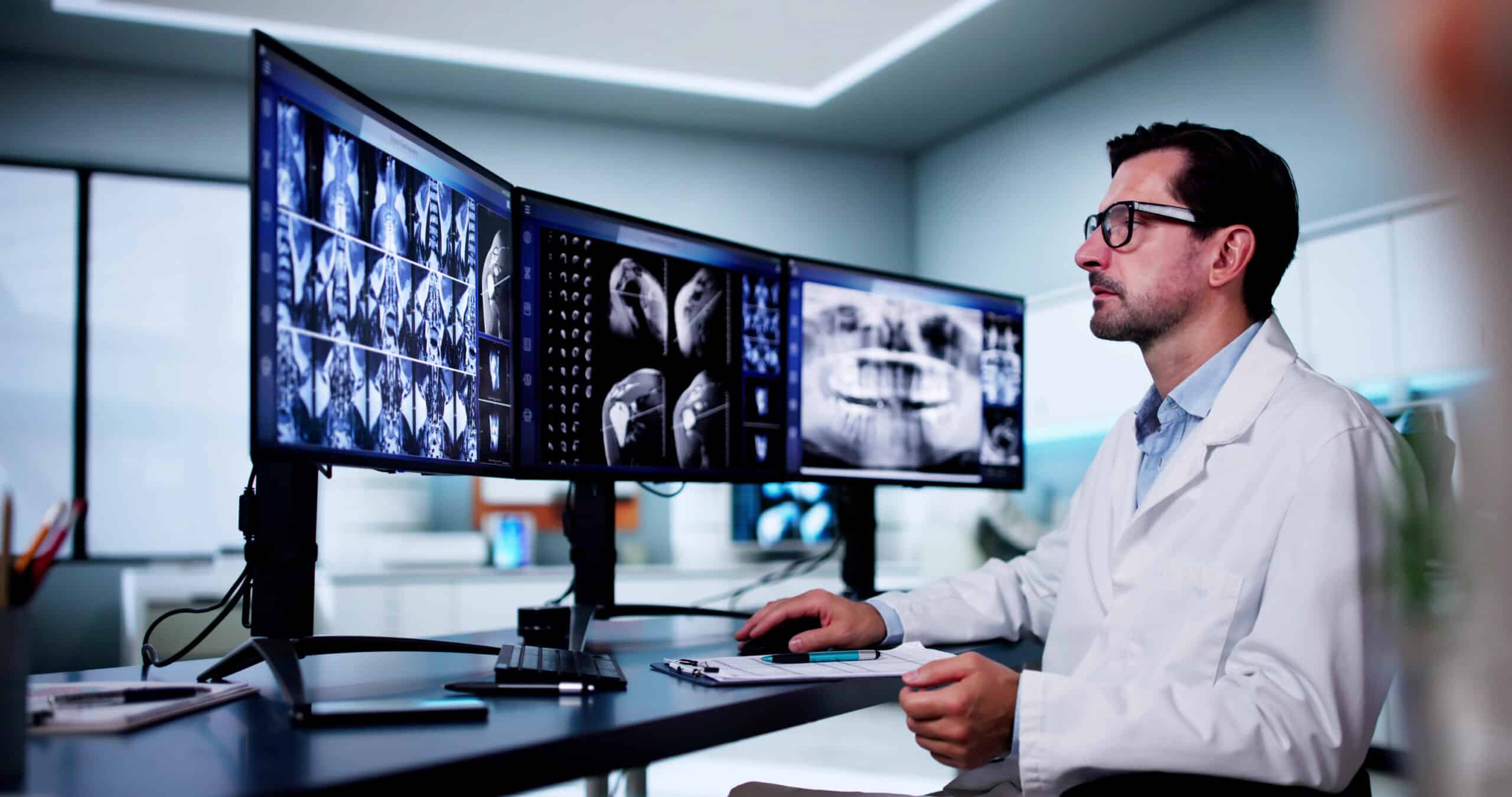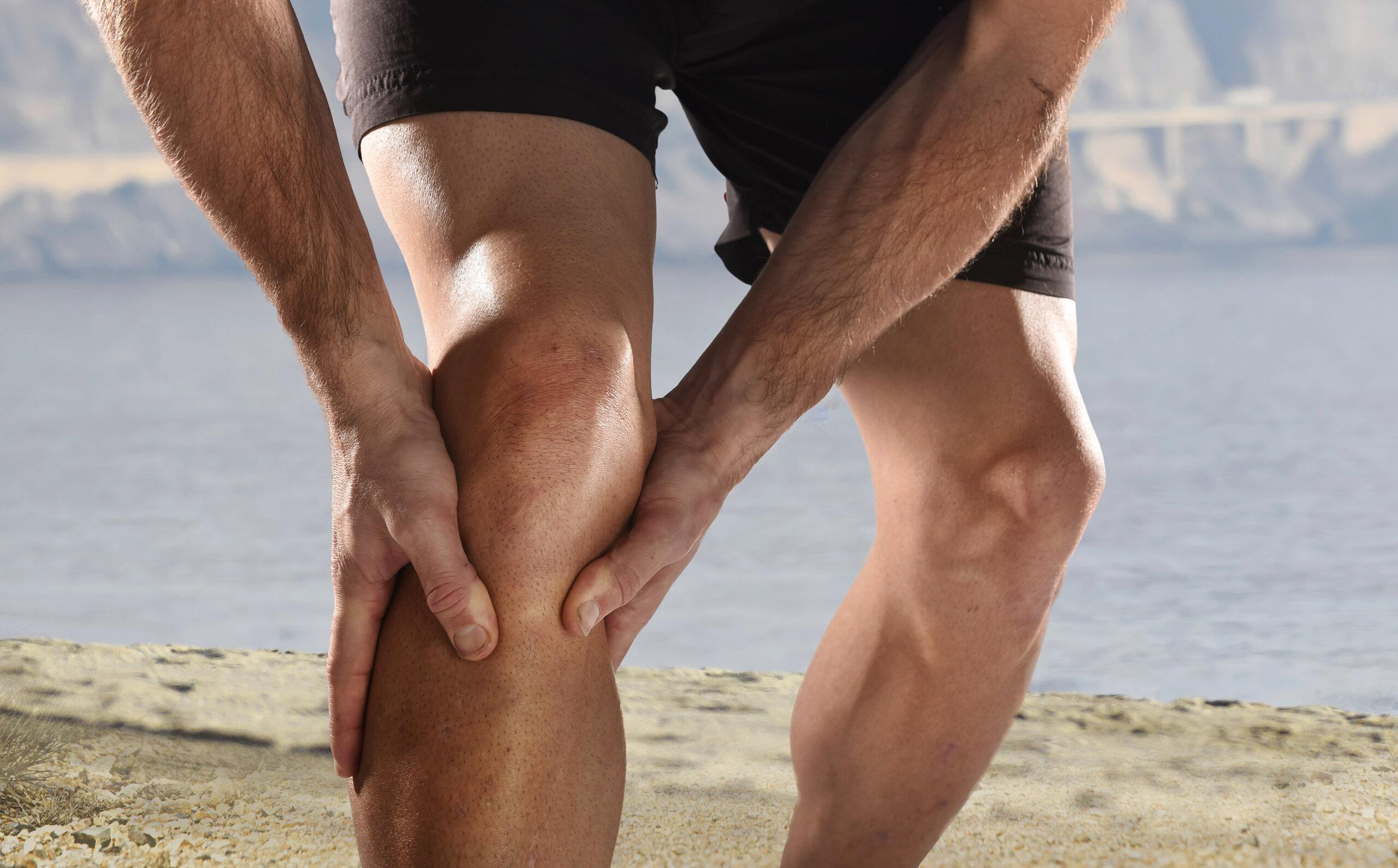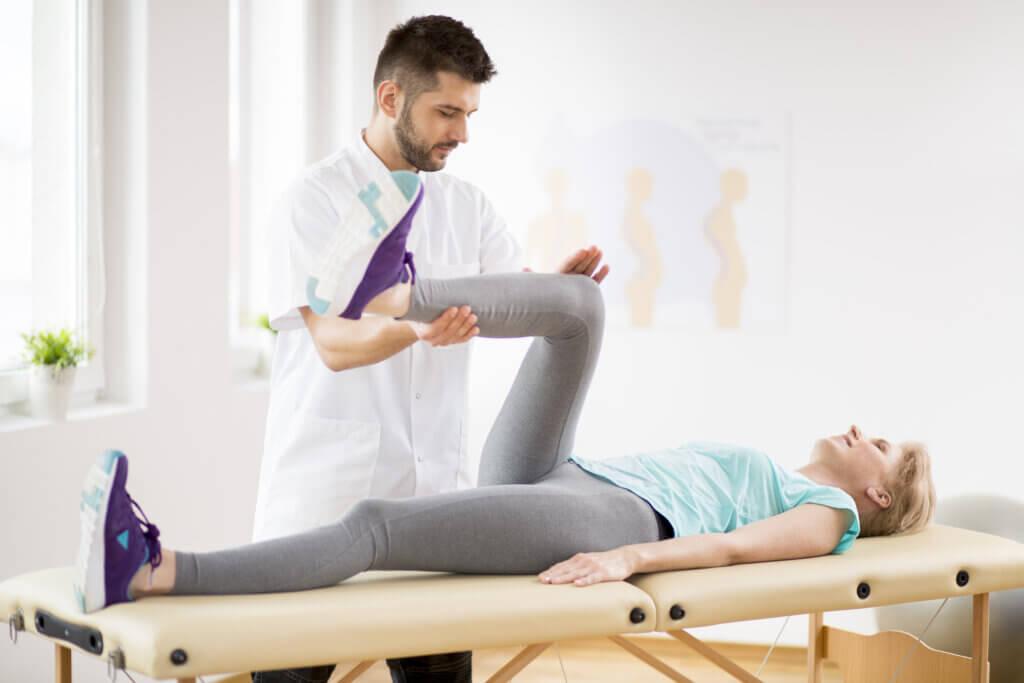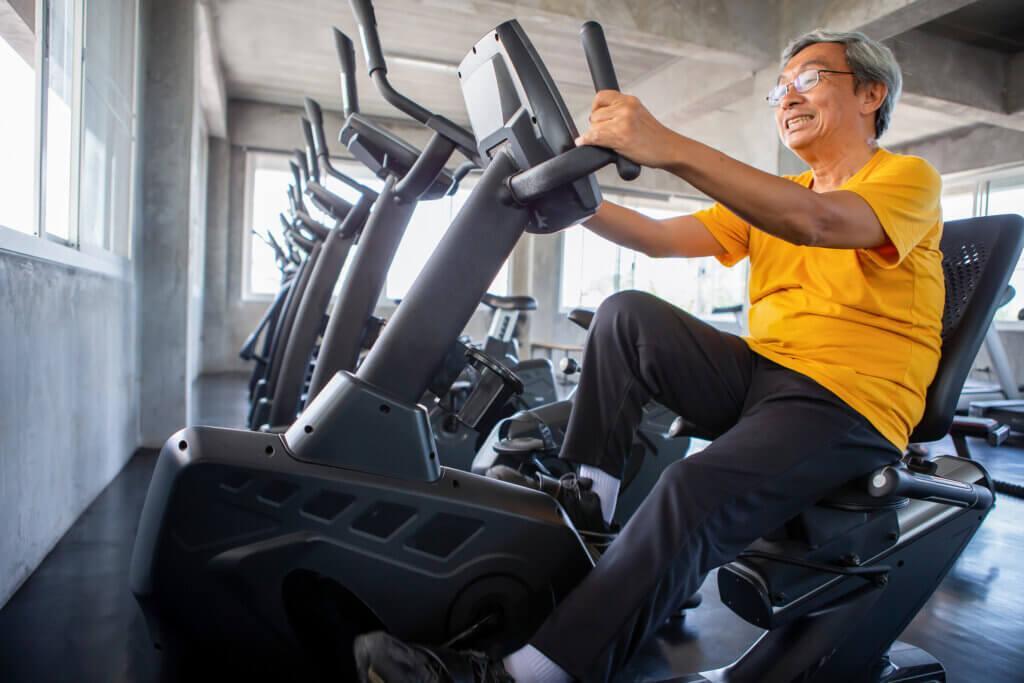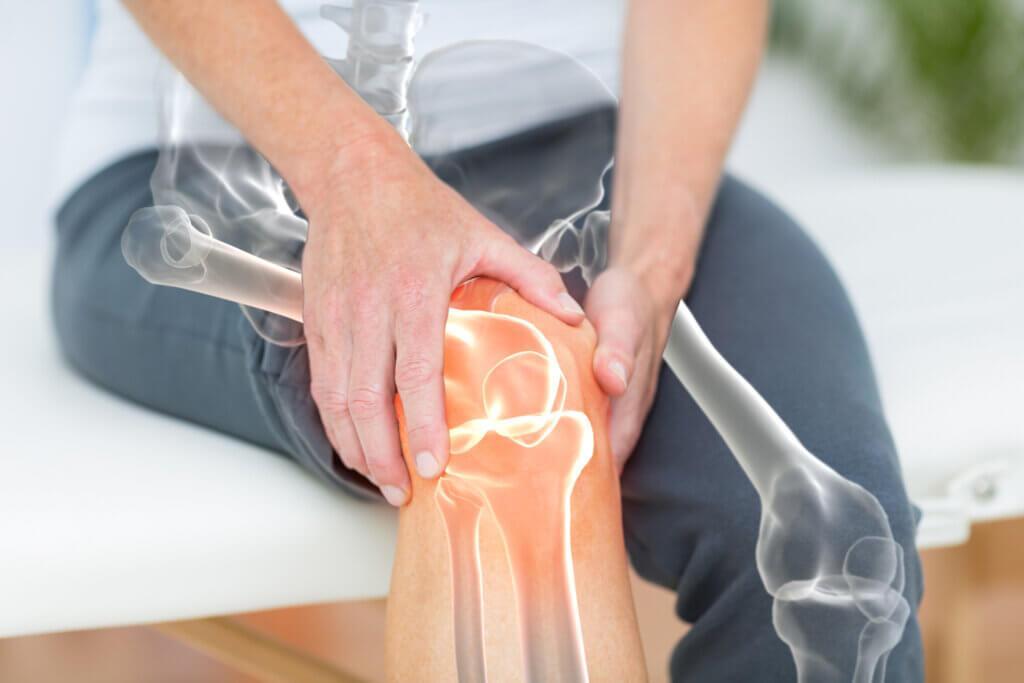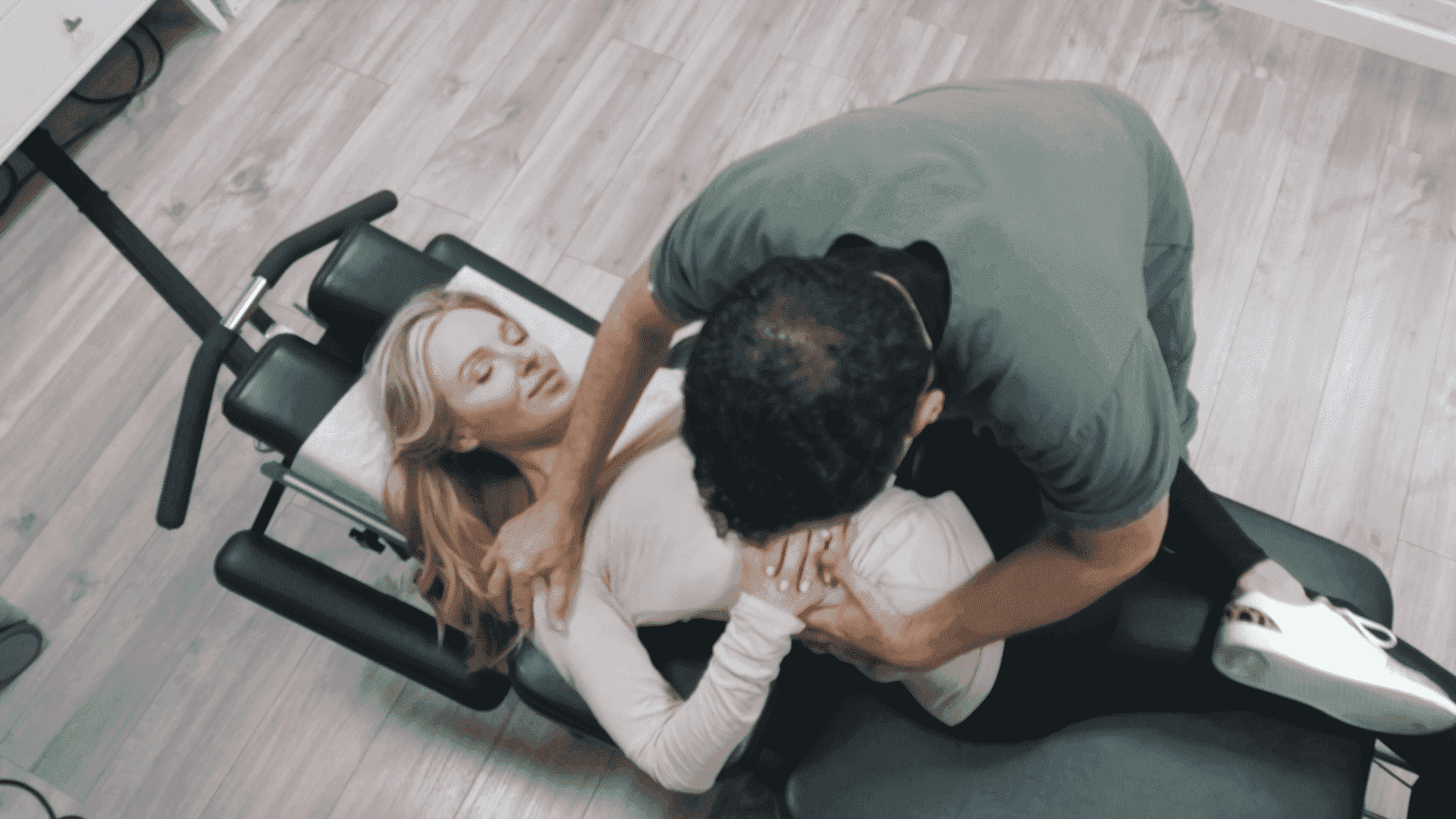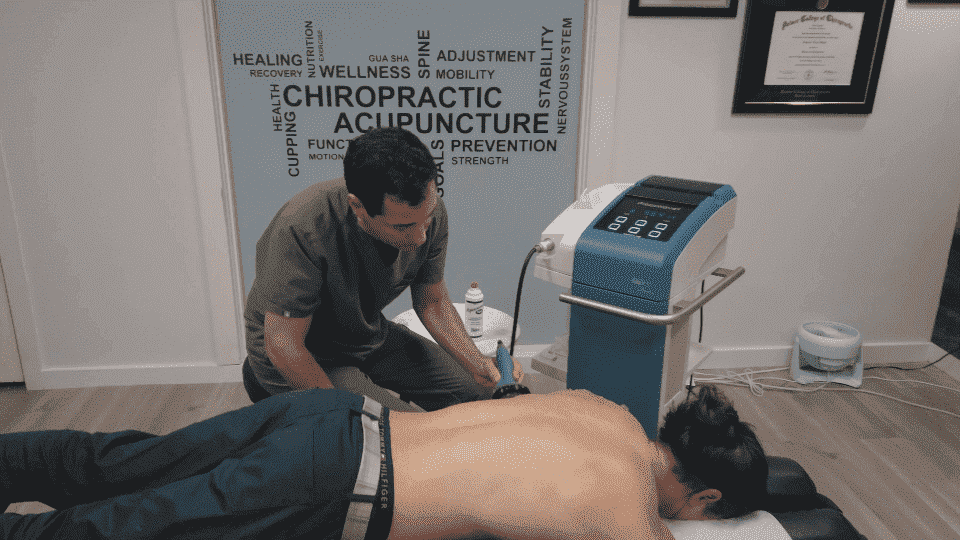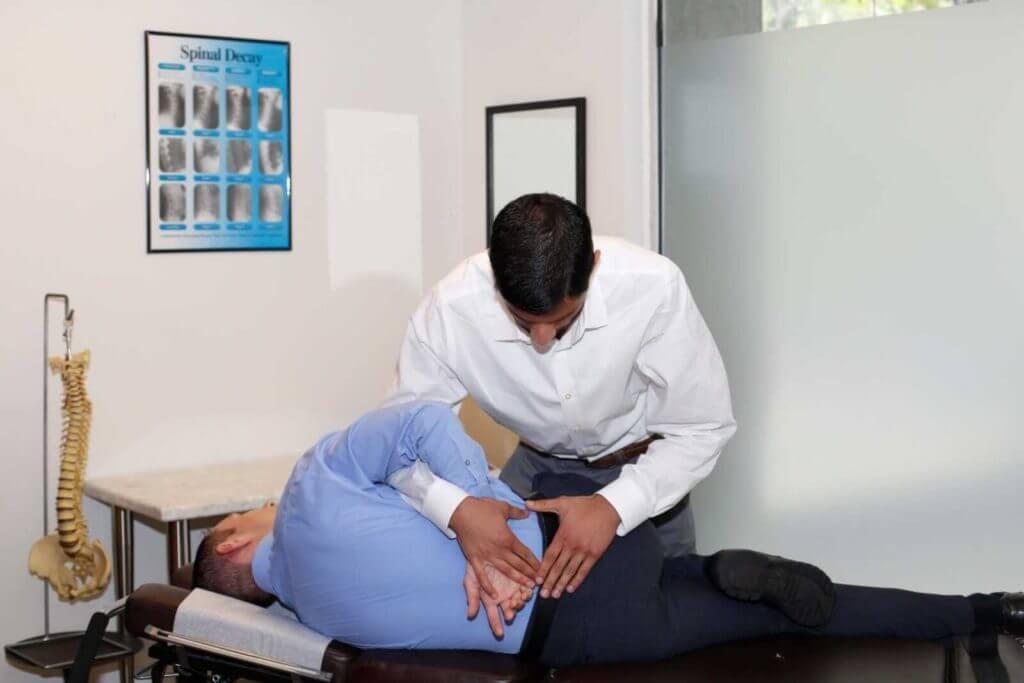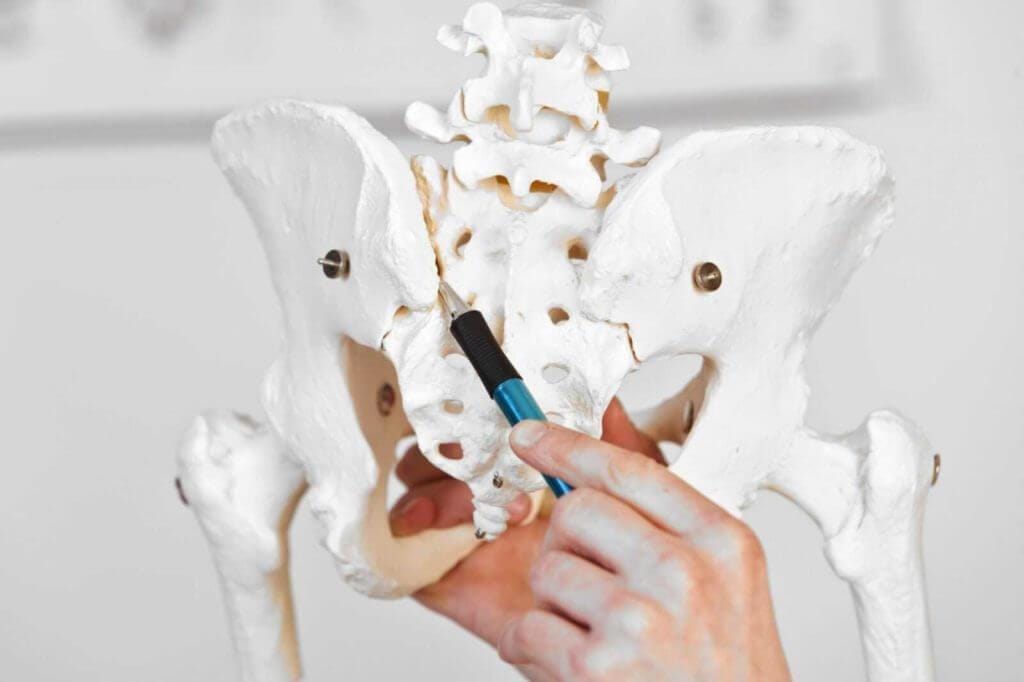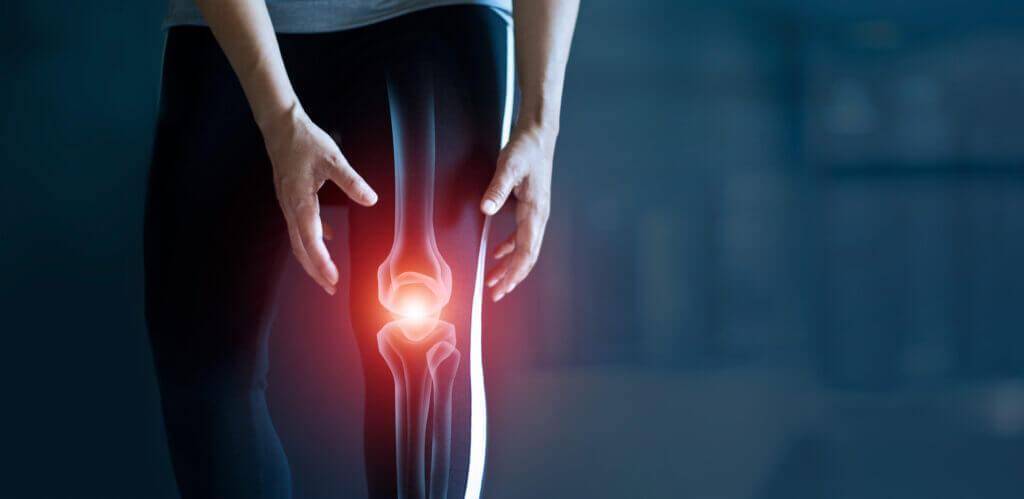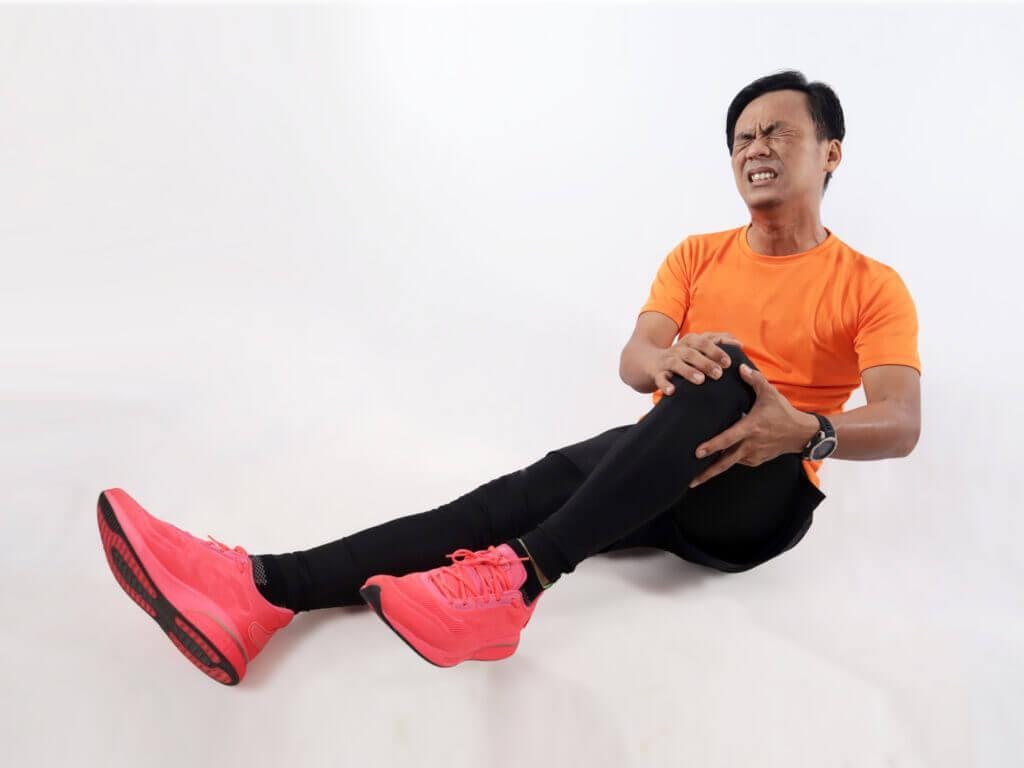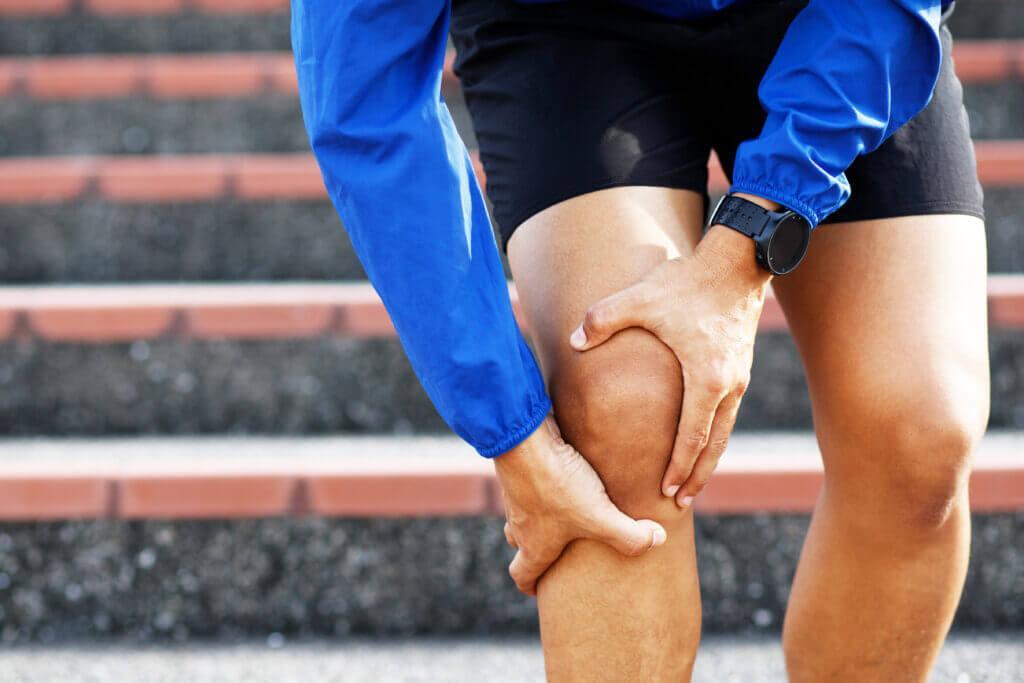Why does my knee hurt? If you’ve never asked this question, you’re the rare exception. Almost everyone experiences knee pain at some stage in life. But the knee pain causes are many.
For some, simple home exercises and remedies can provide fast and full knee pain relief. For other causes of knee pain, you’ll need to take more significant steps, like seeing a knee pain doctor. Either way, it’s important to identify the reason for your knee pain so you can stop the pain, restore mobility, and get back to doing the things you love pain-free.
In this post we’ll explore:
- How the Knee Works
- Why Knees Hurt Where They Do (Side, Back, Kneecap, etc.)
- Why Knees Hurt During Certain Activities (Walking, Sitting, Stairs, etc.)
- Why Knees Hurt at Certain Times (Nightime, Cold, Rain, etc.)
- How A Knee Pain Doctor Can Help

I. How the Knee Works
Your knee is more than just a hinge that allows you to bend and straighten your leg. It’s a complex, weight-bearing joint composed of bones, ligaments, tendons, cartilage, and muscles—all working together to help you move, balance, and absorb shocks.
When even one of these components doesn’t function properly, you can end up asking, “Why does my knee hurt?” Understanding a few key anatomical details will help you see how various issues—ranging from misalignment to wear and tear—can lead to discomfort in different parts of your knee.
According to the Knee Pain Centers of America, 18% of people 18 to 44 experience knee pain, and that rate rises to 37% as people age. 80% of people with osteoarthritis of the knees, a common knee inflammation condition, experience movement limitations.
In fact, knee pain doctor visits represent 1/3 of all visits for musculoskeletal issues.
Basic Structure
Three main bones form your knee joint:
- Femur (thighbone): The upper bone that fits into the hip at one end and meets the knee at the other.
- Tibia (shinbone): The larger bone of the lower leg forms the main support below the knee.
- Patella (kneecap): This small bone sits in front of the knee joint, protecting it and aiding in movement.
Between these bones lie pads of cartilage, known as menisci, which act as shock absorbers. Each meniscus helps spread weight evenly across the joint. Wear or damage to this cartilage can lead to problems like tears, swelling, or pain when you move.
You also have articular cartilage. These form soft caps on the ends of your leg bones. These types of cartilage work together to prevent bone-on-bone rubbing.
Key Supporting Structures
Your knee wouldn’t stay stable without strong bands of connective tissue called ligaments. These ligaments include:
- ACL (Anterior Cruciate Ligament) and PCL (Posterior Cruciate Ligament) inside the joint, preventing forward and backward movement of the tibia relative to the femur.
- MCL (Medial Collateral Ligament) and LCL (Lateral Collateral Ligament) on the inner and outer sides of the knee, preventing side-to-side motion and adding stability.
Meanwhile, tendons—particularly the patellar tendon and quadriceps tendon—attach muscles to bones, allowing your knee to straighten and bend under muscular control.
Any strain or inflammation in these structures can be a significant source of knee pain.
How Knee Anatomy Ties to Pain
Because the knee has so many working parts, knee pain can arise from various issues:
- Cartilage Damage: Injuries or degeneration in the menisci (shock absorber) and articular cartilage (soft bone caps).
- Ligament Sprains or Tears: Overstretching or tearing of the ACL, PCL, MCL, or LCL.
- Tendon Problems: Tendonitis or small tears commonly affect the patellar or quadriceps tendon.
- Muscular Imbalances: Weaker or overly tight muscles can pull the knee out of proper alignment.
- Joint Misalignment: Abnormal walking patterns or posture can strain certain areas of the knee, leading to pain on the inside, outside, front, or back of the joint.
A solid grasp of knee anatomy reveals why so many factors can contribute to discomfort.
By pinpointing which part of this intricate system is at fault, we can start to answer the big question: “Why does my knee hurt?”
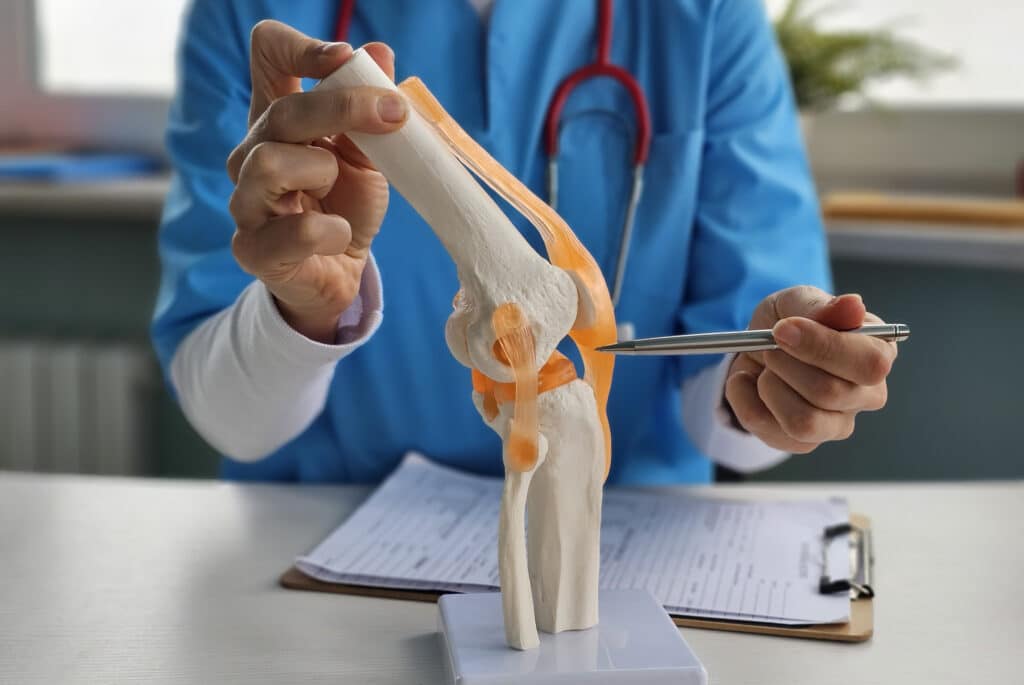
II. Location-Based Knee Pain Answers
Pain can strike any part of your knee—front, back, sides, or even underneath the kneecap. By focusing on where the pain is, you can narrow down possible knee pain causes. This section addresses each location-based question in detail, helping you pinpoint what might be going on inside your knee.
Why Does My Knee Hurt in the Back?
Pain in the back of your knee could stem from a Baker’s cyst. It’s named after the person who discovered it, not because you get it from baking sourdough. This fluid-filled swelling often appears after knee joint damage or inflammation.
It may also relate to strained hamstring tendons, especially if you’ve been doing a lot of running, biking, or other activities involving repetitive knee bending. In some cases, arthritis can cause swelling in the rear part of the joint, leading to persistent aches or stiffness.
If the pain persists, a professional evaluation can determine if there’s a cyst, tendon injury, or other inflammation.
It’s important to rule out more serious causes before deciding on a treatment plan.
Why Does My Knee Hurt on the Side?
Pain on the knee’s outer side (called: lateral knee pain) can be due to lateral collateral ligament (LCL) strain, which happens if you twist your knee awkwardly or sustain a direct hit. Another frequent cause is iliotibial (IT) band syndrome, where the thick band of tissue running along the outer thigh becomes irritated. This often appears in runners or cyclists who increase mileage too quickly.
Lateral meniscus tears can also lead to side knee pain. If you hear a clicking or popping when you move, consider getting an exam to find out if there’s a tear or cartilage damage.
Why Does My Knee Hurt on the Inside?
Pain on the inside of the knee (called: medial knee pain) often suggests issues with the medial meniscus. This is the C-shaped cartilage that cushions the inner part of the joint. A tear here may lead to swelling, tenderness, and limited range of motion. Another possible culprit is a sprain or strain of the medial collateral ligament (MCL), which stabilizes the inner knee.
Less obvious causes include pes anserine bursitis, where inflammation occurs on the inside of the tibia just below the joint. If you notice stiffness, swelling, or pain when you rotate or pivot, you may need imaging or a clinical exam to confirm the exact problem.
At Truspine Chiropractic, our team can order imaging tests, including MRIs, CTs and X-rays, to view the knee structure and identify the root cause of your knee pain. This allows our knee pain doctors to develop a treatment plan that addresses the cause so you can experience faster and more complete healing and knee pain relief.
To get your comprehensive knee pain evaluation and first treatment, schedule an initial consultation.
Why Does My Knee Hurt on the Outside?
When the outer part of the joint hurts, it might be the lateral meniscus, the LCL, or that ever-troublesome IT band. Overuse from running or high-impact sports can lead to inflammation in this area. If you have a job that involves twisting movements or sudden turns, your lateral structures may also get strained.
A chiropractic evaluation can help distinguish between ligament, tendon, or cartilage issues on the outside of your knee.
Identifying the root cause is key to effective, targeted treatment.
Why Does My Knee Hurt Behind It?
Pain “behind” the knee can sound similar to “in the back” but may be slightly different anatomically. For instance, a bursitis or tendon irritation closer to the joint line can make the pain feel deeper than that back of the knee pain we described earlier. Swelling in this region might also suggest internal knee joint damage pressing on nearby tissues.
When in doubt, a thorough evaluation by a knee pain doctor ensures you’re not missing anything, like a subtle ligament sprain or small meniscal tear that can cause occasional flare-ups.
Why Does My Kneecap Hurt?
Pain at or around the kneecap, also known as runner’s knee or patellofemoral pain syndrome, is common when the patella doesn’t track smoothly over the femur. Squatting, climbing stairs, or simply bending the knee can become uncomfortable. Sometimes, the cartilage under the kneecap softens or wears down (chondromalacia patella), causing a grinding sensation.
Patellar tendonitis is another possibility, especially if you’ve been jumping or doing repetitive squats. This inflammation of the tendon connecting your kneecap to your shinbone can lead to localized tenderness.
Why Does My Knee Hurt on the Right Side vs. Left Side?
Sometimes, knee pain is consistently on only one side—your right or left. This could be due to leg-length discrepancies, where one leg is slightly shorter, causing uneven stress on a single knee. Muscle imbalances or old injuries on one side can also lead you to bear weight unevenly.
Have you recently started a sit-stand routine to be less sedentary? Or do you work in retail, education, or food services, where you stand a lot? You might notice your weight shifts more to one leg while you’re standing in one place focused on work. This puts extra strain on the knee on one side of the body. It can stretch and damage the ligament as it tries to keep the knee from bending sideways under pressure.
If you notice you always favor one leg, keep track of when and how pain flares up. A gait analysis can reveal posture and alignment problems, helping you correct any asymmetry before it causes ongoing knee trouble.
Finally, find out what’s causing your knee pain. Non-invasive knee pain solutions await. Schedule an initial consultation.
Why Does My Knee Hurt Under My Kneecap?
Pain under the kneecap typically points to patellar (kneecap) tracking issues or inflammation in the tendons just beneath the patella. When the patella doesn’t move correctly, it grates on the cartilage underneath, which can become a source of chronic pain. Sometimes, fluid or swelling builds in the infrapatellar bursa, causing discomfort beneath the kneecap.
A professional assessment can help you figure out if your pain stems from the tendon, the cartilage, or both. Treatment often involves strengthening exercises, rest, and proper alignment techniques during activities.

Why Does My Knee Hurt in the Front?
Pain in the front often overlaps with kneecap-related issues. Patellofemoral pain syndrome is a leading cause, especially if you feel aches when climbing stairs or sitting for long periods. Repetitive movements that stress the patellar tendon—like running and jumping—can also spark front-of-knee irritation.
Knowing exactly where the pain localizes (above, below, or around the patella) can guide you toward solutions like exercises, orthotics, or chiropractic adjustments. Front-of-knee pain can improve significantly once you address the mechanical issues at play.
Whether you’re experiencing pain on one side, front/back, inside/outside, seeing a knee pain doctor at Truspine Chiropractic helps you get to the root cause of the pain. We can help you restore balance, regrow cartilage, and address knee inflammation and injuries causing you pain.
To get your comprehensive knee pain evaluation and first Knee on Trac knee treatment, schedule an initial consultation.
III: Activity And Movement-Based Knee Pain Answers
Everyday activities—like walking, sitting, climbing stairs, or even running—can reveal a lot about what’s going on inside your knee. When discomfort appears specifically during or after certain movements, it often points to underlying mechanical issues, inflammation, or wear-and-tear in key structures.
Why Does My Knee Hurt Going Down Stairs?
Going downstairs puts extra stress on the patellofemoral joint (where the kneecap meets the thighbone). As you descend, your body weight shifts forward, and your quadriceps work harder to stabilize the knee. This added pressure can irritate the cartilage under your kneecap, leading to sharp or dull pain.
If you have patellar tracking problems, weak quadriceps, or pre-existing knee issues like arthritis, going downstairs can feel especially challenging—even excruciating. Strengthening exercises for your quads and hips—plus ensuring good alignment—often help reduce this discomfort.
Why Does My Knee Hurt Going Up Stairs?
Climbing upstairs puts a similar but slightly different type of load on your knee joint. The strain on the front of the knee can aggravate conditions like patellofemoral pain syndrome or patellar tendonitis. If your knees aren’t tracking properly, each step may grind the kneecap against the femur, creating pain. You might even feel a grinding sensation as structures rub against each other.
Exercises that focus on balancing your leg muscles and improving hip stability can make a real difference. A chiropractor can also help identify any misalignments that heighten this discomfort.
Why Does My Knee Hurt After Sitting?
Have you ever stood up after a long movie or car ride and felt an ache in your knees? That’s often referred to as the “theater sign” or “movie-goer’s knee,” closely tied to patellofemoral pain syndrome. When your knees stay bent for a long time, the pressure behind the kneecap can cause pain or stiffness.
Additionally, those who sit for very long hours, like people with desk jobs, lose lubrication in their knees as they stay in more-or-less one position for two, four, and sometimes eight hours. Lack of lubrication increases the rate at which cartilage breaks down and can exacerbate the stiffness and pain after prolonged sitting.
If your pain lingers once you start moving, you could be dealing with arthritis or soft tissue inflammation. Try consistently stretching your quads and hamstrings, as well as taking regular breaks to stand and walk. If possible, extend one or both legs every several minutes to keep the joints lubricated and to relieve that pressure.
Even a few seconds in a different position every 30 minutes can reduce the risk that you experience this phenomenon. Obviously, we’d like to see you getting up and moving around for five minutes every hour or so if you’re sitting for longer than it takes to watch a movie.
You’ll feel even better if you make THIS a habit!
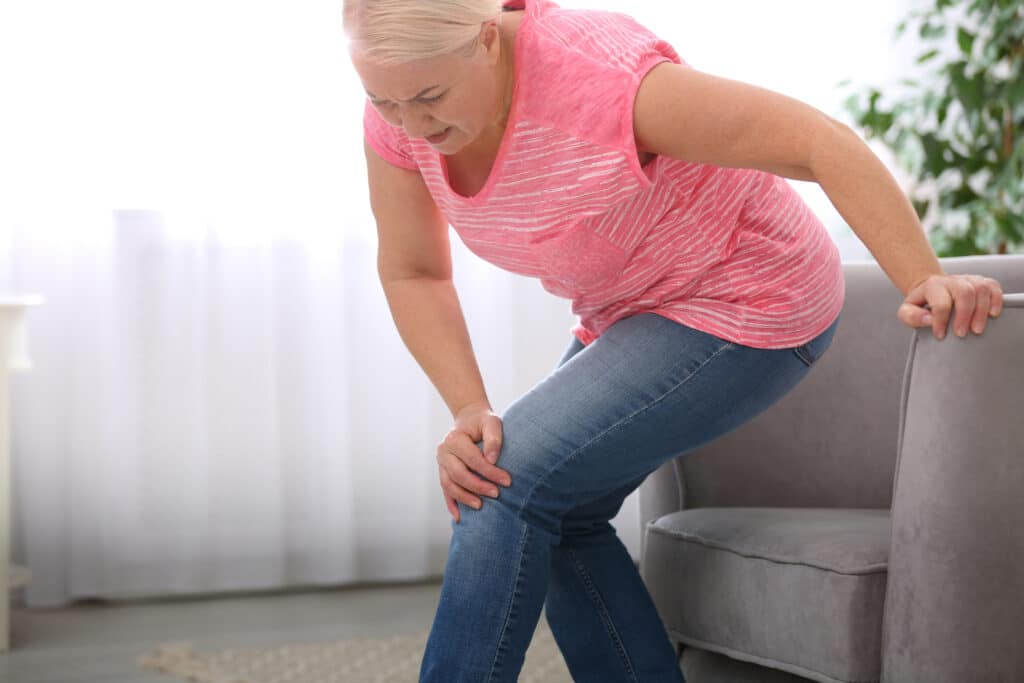
Why Does My Knee Hurt After Walking?
Walking, while generally healthy, can still stress your knee if there’s an underlying weakness or alignment issue. Overpronation (rolling inward at the ankle), unsupportive footwear, or a sudden increase in distance can cause overuse injuries. Conditions like patellar tendonitis, meniscus irritation, or ligament strains may flare up after longer walks.
Addressing foot mechanics, maintaining a moderate walking pace, and gradually increasing your mileage are simple ways to reduce post-walk discomfort. If pain remains constant, a professional evaluation is your next step.
Schedule an initial consultation.
Why Does My Knee Hurt After Squats?
Squats are a staple exercise for lower-body strength but can be tough on the knees. Improper form—like letting your knees drift too far forward, out, or in—can overload the joint. If you lack hip or core stability, you may be a little wobbly as you go down. This places extra stress on your tendons and ligaments around the kneecap.
It’s definitely something you can overcome by strengthening your legs.
But that may require you to do leg exercises that don’t carry your entire body weight.
Common culprits behind post-squat pain include patellar tendonitis, meniscal strains, or tracking problems. Working with a trainer or chiropractor to perfect your squat form can reduce the likelihood of injury.
The knee pain doctors at Truspine Chiropractic take time to demonstrate proper form when lifting, squatting, walking, and more. We want you to experience complete and profound relief from your knee pain. And very often, that starts with fixing a balance, form, or structural issue.
You deserve to live pain-free! To get your comprehensive knee pain evaluation and first Knee on Trac, schedule an initial consultation.

Why Does My Knee Hurt So Bad After Running?
Running is high-impact, subjecting your knees to repetitive stress. Overuse injuries like patellar tendonitis, iliotibial (IT) band syndrome, or meniscus strains are common among runners—particularly when increasing distance or intensity too fast. If your shoes are worn or don’t match your foot type, your knees may take a beating.
Runner’s knee, also known as patellofemoral pain syndrome (PFPS), is a common condition where pain develops on or under the kneecap. It’s generally the result of musculoskeletal imbalances that can be fixed.
Knee pain after running is not normal. If you love to run, you deserve to keep doing what you love without pain.
Rest, ice, and gentle stretching can relieve minor flare-ups. It’s also smart to analyze your running form, replace your footwear regularly, and incorporate strength training to stabilize your knees.
Why Does My Knee Cap Hurt When I Bend It?
Bending your knee requires smooth gliding of the kneecap along the femoral groove. If something interrupts that glide—like cartilage damage or tight tissues around the kneecap—you might feel pain, popping, or grinding. Patellofemoral pain syndrome is a frequent cause, especially among runners or those who do a lot of knee-bending activities.
Strengthening exercises for the quads and hips, as well as techniques to improve patellar tracking, can bring relief. If bending the knee remains problematic, an assessment can pinpoint the exact cause.
IV. Environmental And Situational Knee Pain Answers
Knee pain isn’t only about what you do; it can also reflect the conditions you’re in. From chilly weather to prolonged stillness, certain scenarios can aggravate discomfort. Let’s tackle how environmental factors and specific situations might trigger knee pain.
Why Does My Knee Hurt in the Cold?
You’ve likely heard someone say, “My knee hurts because it’s cold outside.” There’s some truth to this. Colder temperatures can cause your joints and surrounding tissues to tighten, reducing blood flow. As a result, synovial fluid—which cushions your knee—may thicken, making movement less smooth and more painful.
Dressing warmly and doing light warm-ups before going outside can help. Using a knee sleeve or compression brace can also keep the joint warm and supported. If you consistently feel worse in low temperatures, you might have underlying joint inflammation or arthritis that reacts strongly to the weather.
Why Does My Knee Hurt When It Rains?
Some people’s joints become more sensitive when the barometric pressure drops before a storm, though the exact reasons aren’t fully understood. Some people say they can feel “a storm coming” because their knees ache.
If your knees ache before or during rain, focus on anti-inflammatory strategies like nutrition and leg strengthening while also considering that you may have a structural issue making the inflammation and pain worse.
Why Does My Knee Hurt All the Time?
If you find yourself asking this, chances are your knee pain has turned into more than an occasional ache. Here are a few key reasons why it might be constant:
- Chronic Conditions: Arthritis (osteoarthritis or rheumatoid arthritis) can cause persistent inflammation. If left untreated, it may wear down cartilage and lead to ongoing discomfort.
- Untreated Injuries: A sprain or tear that never fully healed can evolve into chronic pain, affecting daily activities.
- Misalignment or Postural Issues: Poor walking gait or an imbalanced pelvis puts extra pressure on your knees, causing a near-constant ache.
- Overuse and Repetitive Strain: People who stand or walk for extended periods—either at work or during sports—may develop lingering pain due to overuse.
If your knee pain feels permanent, it’s time for a professional evaluation. Long-standing problems rarely go away on their own, and a thorough exam is crucial for customized knee pain treatment.
To get the personalized knee pain treatment that you need to live actively and well and schedule an initial consultation.
Why Does My Knee Hurt in the Morning?
Morning knee pain often indicates stiffness or inflammation that has built up overnight. Conditions like osteoarthritis, rheumatoid arthritis, or even mild tendonitis can feel worse after hours of limited movement. As you start moving around, blood flow improves, helping ease discomfort.
If morning pain persists or intensifies, consider an evaluation. Early-stage arthritis or other chronic inflammatory issues benefit from prompt care before they progress.
Why Does My Knee Hurt Only at Night?
Nighttime knee pain can have several causes. Inflammation from daytime activity might peak when you finally rest. Bursitis, tendonitis, or certain forms of arthritis can become more pronounced once you’re off your feet. Additionally, lying flat might alter knee circulation or nerve pathways, triggering pain.
Keeping a log of when and how the pain occurs can help your knee pain doctor identify patterns—like particular sleeping positions or late-night activity—that worsen symptoms.
Why Does My Knee Hurt So Bad at Night?
If your knee pain is especially severe, you might be dealing with advanced arthritis or a significant injury like a meniscal tear. Swelling in the joint, combined with inactivity while you’re lying down, can make sensations feel more intense. In some cases, nerve irritation also flares up when joints aren’t moving.
Using supportive pillows, gently stretching before bed, and elevating the knee might offer relief. If the pain disrupts your sleep consistently, it’s likely time for professional help to investigate underlying causes.
Recognizing how activity and time of day impact your knee can shine a light on what’s truly behind the discomfort. By matching these clues with the right interventions—adjusting your workout routine, improving your form, or seeking specialized care—you’re closer to overcoming that nagging question: “Why does my knee hurt?”
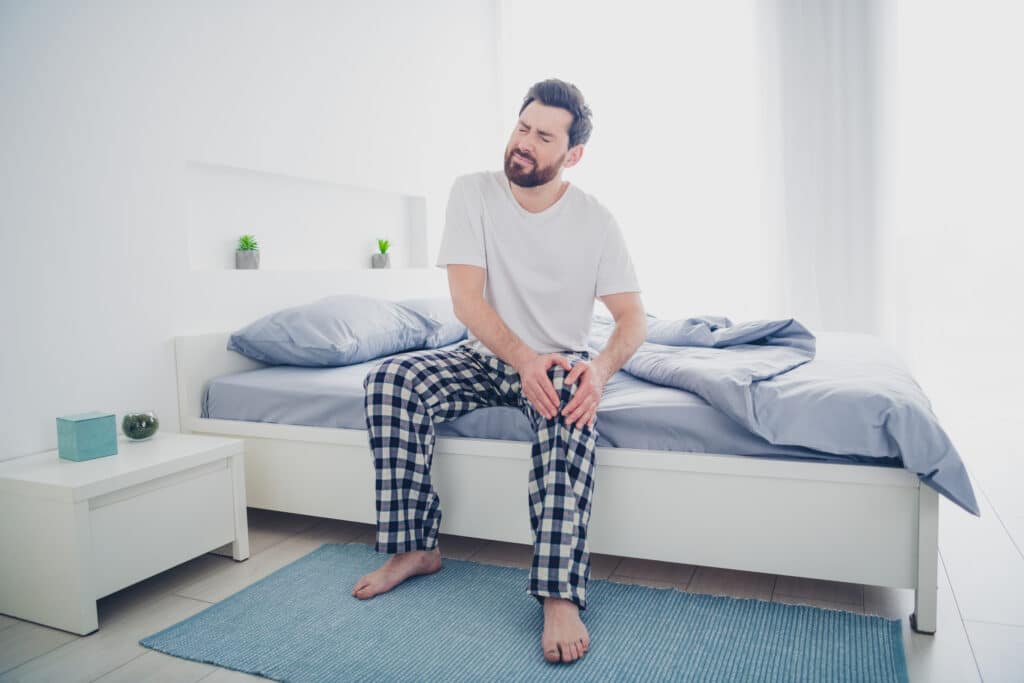
Why Does My Knee Hurt Randomly?
Sudden or “out-of-the-blue” knee pain can be confusing, especially when you haven’t changed your daily routine. Here’s what might be happening:
- Flare-Ups of Old Injuries: Even if an injury seemed to heal, the affected tissues may remain vulnerable and cause occasional pain.
- Muscle Imbalances: If your quads and hamstrings are not equally strong, your knee joint might be pulled out of its optimal alignment at unexpected times.
- Lifestyle or Minor Overuse: A simple walk on uneven ground or an impromptu run without warming up could trigger pain if your knee wasn’t prepared for it.
Random knee pain doesn’t necessarily mean severe damage is lurking. But it does hint that something isn’t quite right—either structurally or in your movement patterns.
Why Would My Knee Hurt for No Reason?
If there’s pain yet you can’t pinpoint an obvious cause—no recent injury, no intense workout—the culprit could be hidden or subtle:
- Early Wear and Tear: Degeneration of joint cartilage often starts slowly, so you might not notice it until it becomes painful.
- Low-Grade Inflammation: Low levels of swelling can linger in the joint, especially if there’s an underlying issue like mild arthritis or a past sprain.
- Metabolic or Systemic Conditions: Sometimes, conditions like diabetes or thyroid imbalances contribute to joint pain, even if they don’t directly target the knee.
When knee pain seems to come “out of nowhere,” it’s still worth mentioning to your knee pain doctor. Often, there’s a root cause just waiting to be uncovered.
V. Possible Reasons for Knee Pain
Knee pain doesn’t always stem from a single, obvious injury. Sometimes, multiple factors—from your exercise habits to underlying health conditions—converge to create discomfort. Understanding these possible reasons can help you recognize when your lifestyle choices or physical misalignments might contribute to persistent knee troubles.
Overuse and Repetitive Stress
Daily activities like running, squatting, or climbing stairs can place repetitive stress on your knees. If you ramp up your mileage too quickly or repeatedly bend your knees under significant weight, small injuries can accumulate over time. Tendonitis and strains often develop when the body doesn’t get enough rest between workouts.
A key preventive measure is balancing activity with recovery—stretching, proper warm-ups, and rest days. If overuse injuries keep flaring up, consider re-evaluating your form or workout routine with a healthcare professional or coach.
Age-Related Degeneration
As you get older, your cartilage naturally thins, and your joints may lose some of their cushioning ability. Osteoarthritis is the most common form of arthritis in older adults, often causing stiffness and pain that worsen after inactivity or in cold weather. While age-related wear and tear is normal, early intervention can slow its progression.
Maintaining a healthy weight and staying active with low-impact exercises—like swimming or cycling—can help preserve cartilage health. Regular chiropractic visits may also relieve some of the stress on your knees by promoting better joint alignment.
Trauma or Acute Injuries
A sudden twist, fall, or direct impact can lead to ligament sprains, muscle strains, or even fractures. Sports injuries often involve tears to the ACL or meniscus, causing immediate swelling and pain. Prompt diagnosis is crucial, as untreated injuries can worsen and potentially become chronic.
If you suspect a traumatic injury, use the RICE method (rest, ice, compression, elevation) as first aid. Seek professional evaluation to determine the severity of the damage and to prevent long-term complications.
You deserve to pursue the active, pain-free lifestyle you want to live. To get your comprehensive knee pain evaluation and first Knee on Trac, schedule an initial consultation.
Alignment and Gait Issues
Misalignments in your hips, spine, or feet can shift how you distribute weight across your knees. Over time, incorrect gait patterns can contribute to uneven wear on cartilage and ligaments. Bow-legged or knock-kneed postures, for example, put extra stress on specific parts of the joint.
A gait analysis can reveal whether you’re unintentionally favoring one leg or turning your feet in a way that strains the knee. Correcting alignment often involves targeted exercises, orthotics, or chiropractic adjustments to restore proper posture.
Systemic Conditions
Certain diseases and conditions can influence knee health. Rheumatoid arthritis, an autoimmune disease, can cause joint swelling and intense pain. Lupus, gout, and even psoriasis can have similar effects. If your knee pain fluctuates with overall flare-ups or is accompanied by other systemic symptoms—like fatigue or fever—you might need a more comprehensive medical evaluation.
In some cases, managing the underlying condition through diet, lifestyle adjustments, and, when needed, medication can significantly reduce knee discomfort.
Nutritional Deficiencies
Your joints rely on a consistent supply of nutrients—like vitamin D, calcium, and collagen—to maintain bone density and cartilage strength. Diets low in these nutrients may leave you more vulnerable to joint aches and slow recovery after minor injuries.
Consider getting your vitamin levels checked if you experience unexplained pain or if you follow a restricted diet. Incorporating anti-inflammatory foods—such as leafy greens, berries, winter squashes, turmeric, ginger, and omega–3–rich foods—can also support overall joint health.
Lifestyle Factors
Habits like smoking and excessive alcohol consumption can inhibit healing and exacerbate inflammation. Obesity adds stress to the knee joint, making pain more likely in everyday activities like walking or climbing stairs. Sedentary lifestyles also contribute to weaker muscles and stiffer joints, both of which can accelerate knee problems.
Taking small steps—like adopting a balanced diet, quitting smoking, and incorporating moderate exercise—helps lessen your risk of knee pain and supports a healthier, more active life.
When it comes to knee discomfort, pinpointing the root cause isn’t always straightforward. Often, it’s a blend of factors—age, physical strain, alignment issues, or underlying conditions. By exploring how these reasons might interact in your life, you’re more likely to uncover effective solutions, whether that’s changing your workout routine, getting fitted for orthotics, or consulting a knee pain doctor for a thorough examination.
In other words, the vast majority of knee pain is caused by structural issues, damaged tissues, and lost cartilage. Truspine Chiropractors are knee pain doctors who specialize in treating these kinds of issues by addressing the cause of the pain.
In most cases, you can become knee pain-free without potentially harmful medications or surgery.
It’s time to live pain-free without invasive surgeries. To get your comprehensive knee pain evaluation and first Knee on Trac, schedule an initial consultation.
VI: How Chiropractors Treat Knee Pain
Conventional approaches to knee pain often revolve around pain relievers, injections, or surgery. While these methods can bring temporary relief, they don’t always tackle the root cause. For example, an invasive knee surgery might fix the issue for now. But if you’re continuing to move in ways that put uneven stress on the knee, the injury is probable. That knee pain surgery that once provided relief starts feeling like your knee before—or worse.
Chiropractic care offers a holistic, non-invasive alternative. By focusing on alignment and biomechanics, chiropractors aim to restore the body’s natural balance so the knee can function more efficiently and heal more effectively.
Chiropractors look at how the entire musculoskeletal system works together. If your spine or hips are misaligned, your knees may bear uneven weight with every step or prolonged standing, leading to chronic pain or recurrent injuries.
We don’t mask discomfort with medication. Chiropractic adjustments address alignment to reduce stress on the knee joint.
Truspine’s Approach to Knee Pain
At Truspine, we start with a thorough assessment of your posture, gait, and lifestyle habits. If we might find you have tight quads, weak glutes or misalignments in the hips or spine —that may be straining your knees— We’ll create a customized plan. This might include:
- Manual Adjustments: Aimed at correcting misalignments in the spine or pelvis that affect knee mechanics.
- Soft Tissue Therapies: Techniques like myofascial release can reduce tension in the muscles and tendons around the knee.
- Targeted Exercises: Strengthening the hips, core, and thighs can relieve pressure on the knee.
- Lifestyle and Posture Coaching: Small changes, such as adjusting how you stand, sit, or walk, can have a big impact on knee health.
- Cold Laser Therapy: Non-invasive light therapy can reduce inflammation and speed healing.
- Instrument-Assisted Soft Tissue Mobilization (IASTM): Tools like Graston Technique help break down scar tissue and improve circulation around the knee.
- Rehabilitative Exercises: Custom exercises that strengthen stabilizing muscles, promoting a balanced knee joint.
- Knee on TracTM: Many believe that once cartilage is gone, that’s it! But that simply isn’t true. Cartilage grows new and healthier tissues in the right environment. Knee on Trac is a specialized cartilage-restoring device that gently increases the space in your knees. This encourages cartilage to expand and grow into the space.
Addressing the Root Cause
At the end of the day, a chiropractor works to find the root cause, correct it, and stop the pain.
Sometimes, knee pain develops because of foot issues—like fallen arches—or hip imbalances that alter your leg’s alignment. A chiropractor’s job is to pinpoint those underlying problems. By restoring proper movement patterns, chiropractic care may help you avoid repetitive injuries and long-term joint damage.
Get the Pain Relief You Deserve
At Truspine, our knee pain doctors are here to help you get to the root cause of your knee pain. Through non-invasive and innovative knee pain treatments, we can slow and reverse cartilage loss, reduce inflammation, and restore proper movement patterns without dependence on medication.
It’s time to get the knee pain relief you deserve. To get your comprehensive knee pain evaluation and first Knee on Trac, schedule an initial consultation.
